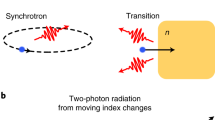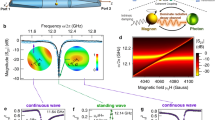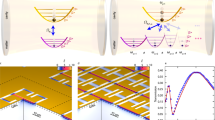Abstract
The goal to achieve arbitrary control of photon flow has motivated much of the recent research on photonic crystals and metamaterials. As a new mechanism for controlling photon flow, we introduce a scheme that generates an effective magnetic field for photons. We consider a resonator lattice in which the coupling constants between the resonators are harmonically modulated in time. With appropriate choice of the spatial distribution of the modulation phases, an effective magnetic field for photons can be created, leading to a Lorentz force for photons and the emergence of topologically protected one-way photon edge states that are robust against disorders—without the use of magneto-optical effects.
This is a preview of subscription content, access via your institution
Access options
Subscribe to this journal
Receive 12 print issues and online access
$209.00 per year
only $17.42 per issue
Buy this article
- Purchase on Springer Link
- Instant access to full article PDF
Prices may be subject to local taxes which are calculated during checkout





Similar content being viewed by others
References
Klitzing, K. V., Dorda, G. & Pepper, M. New method for high-accuracy determination of the fine-structure constant based on quantized Hall resistance. Phys. Rev. Lett. 45, 494–497 (1980).
Tsui, D. C., Stormer, H. L. & Gossard, A. C. Two-dimensional magnetotransport in the extreme quantum limit. Phys. Rev. Lett. 48, 1559–1562 (1982).
Laughlin, R. Quantized Hall conductivity in two dimensions. Phys. Rev. B 23, 5632–5633 (1981).
Halperin, B. I. Quantized Hall conductance, current-carrying edge states, and the existence of extended states in a two-dimensional disordered potential. Phys. Rev. B 25, 2185–2190 (1982).
Thouless, D., Kohmoto, M., Nightingale, M. & Nijs, M. Quantized Hall conductance in a two-dimensional periodic potential. Phys. Rev. Lett. 49, 405–408 (1982).
Hatsugai, Y. Chern number and edge states in the integer quantum Hall effect. Phys. Rev. Lett. 71, 3697–3700 (1993).
Yablonovitch, E. Inhibited spontaneous emission in solid-state physics and electronics. Phys. Rev. Lett. 58, 2059–2062 (1987).
John, S. Strong localization of photons in certain disordered dielectric superlattices. Phys. Rev. Lett. 58, 2486–2489 (1987).
Joannopoulos, J. D., Villeneuve, P. R. & Fan, S. Photonic crystals: putting a new twist on light. Nature 386, 143–149 (1997).
Pendry, J. B. Negative refraction makes a perfect lens. Phys. Rev. Lett. 85, 3966–3969 (2000).
Smith, D. R., Pendry, J. B. & Wiltshire, M. C. K. Metamaterials and negative refractive index. Science 305, 788–792 (2004).
Shalaev, V. M. Optical negative-index metamaterials. Nature Photon. 1, 41–48 (2007).
Onoda, M., Murakami, S. & Nagaosa, N. Hall effect of light. Phys. Rev. Lett. 93, 083901 (2004).
Raghu, S. & Haldane, F. D. M. Analogs of quantum-Hall-effect edge states in photonic crystals. Phys. Rev. A 78, 033834 (2008).
Haldane, F. D. M. & Raghu, S. Possible realization of directional optical waveguides in photonic crystals with broken time-reversal symmetry. Phys. Rev. Lett. 100, 013904 (2008).
Wang, Z., Chong, Y., Joannopoulos, J. D. & Soljačić, M. Reflection-free one-way edge modes in a gyromagnetic photonic crystal. Phys. Rev. Lett. 100, 013905 (2008).
Wang, Z., Chong, Y., Joannopoulos, J. D. & Soljačić, M. Observation of unidirectional backscattering-immune topological electromagnetic states. Nature 461, 772–775 (2009).
Yu, Z., Veronis, G., Wang, Z. & Fan, S. One-way electromagnetic waveguide formed at the interface between a plasmonic metal under a static magnetic field and a photonic crystal. Phys. Rev. Lett. 100, 023902 (2008).
Hafezi, M., Demler, E. A., Lukin, M. D. & Taylor, J. M. Robust optical delay lines with topological protection. Nature Phys. 7, 907–912 (2011).
Umucallar, R. O. & Carusotto, I. Artificial gauge field for photons in coupled cavity arrays. Phys. Rev. A 84, 043804 (2011).
Kane, C. L. Graphene and the quantum spin Hall effect. Int. J. Mod. Phys. B 21, 1155–1164 (2007).
Chen, W.-J. et al. Observation of backscattering-immune chiral electromagnetic modes without time reversal breaking. Phys. Rev. Lett. 107, 023901 (2011).
Fang, K., Yu, Z. & Fan, S. Photonic Aharonov–Bohm effect based on dynamic modulation. Phys. Rev. Lett. 108, 153901 (2012).
Winn, J. N., Fan, S., Joannopoulos, J. D. & Ippen, E. P. Interband transitions in photonic crystals. Phys. Rev. B 59, 1551–1554 (1999).
Dong, P., Preble, S. F., Robinson, J. T., Manipatruni, S. & Lipson, M. Inducing photonic transitions between discrete modes in a silicon optical microcavity. Phys. Rev. Lett. 100, 033904 (2008).
Yu, Z. & Fan, S. Complete optical isolation created by indirect interband photonic transitions. Nature Photon. 3, 91–94 (2009).
Luttinger, J. M. The effect of a magnetic field on electrons in a periodic potential. Phys. Rev. 84, 814–817 (1951).
Hofstadter, D. R. Energy levels and wave functions of Bloch electrons in rational and irrational magnetic fields. Phys. Rev. B 14, 2239–2249 (1976).
Sherley, J. H. Solution of the Schrödinger equation with a Hamiltonian periodic in time. Phys. Rev. 138, B979–B987 (1965).
Samba, H. Steady states and quasi energies of a quantum-mechanical system in an oscillating field. Phys. Rev. A 7, 2203–2213 (1973).
Xu, Q., Schmidt, B., Pradhan, S. & Lipson, M. Micrometre-scale silicon electro-optic modulator. Nature 435, 325–327 (2005).
Kuo, Y.-H. et al. Strong quantum-confined Stark effect in germanium quantum-well structures on silicon. Nature 437, 1334–1336 (2005).
Villeneuve, P. R., Fan, S. & Joannopoulos, J. D. Microcavities in photonic crystals: mode symmetry, tunability, and coupling efficiency. Phys. Rev. B 54, 7837–7842 (1996).
Takahashi, Y. et al. High-Q nanocavity with a 2-ns photon lifetime. Opt. Express 15, 17206–17213 (2007).
Notomi, M., Kuramochi, E. & Tanabe, T. Large-scale arrays of ultrahigh-Q coupled nanocavities. Nature Photon. 2, 741–747 (2008).
Povinelli, M. L., Johnson, S. G., Fan, S. & Joannopoulos, J. D. Emulation of two-dimensional photonic crystal defect modes in a photonic crystal with a three-dimensional photonic band gap. Phys. Rev. B 64, 075313 (2001).
Ishizaki, K. & Noda, S. Manipulation of photons at the surface of three-dimensional photonic crystals. Nature 460, 367–370 (2009).
Lira, H., Yu, Z., Fan, S. & Lipson, M. Electrically driven nonreciprocity induced by interband photonic transition on a silicon chip. Phys. Rev. Lett. 109, 033901 (2012).
Pozar, D. M. in Microwave Engineering Ch. 12, 618 (Wiley, 2005).
Koch, J., Houck, A. A., Le Hur, K. & Girvin, S. M. Time-reversal-symmetry breaking in circuit-QED-based photon lattices. Phys. Rev. A 82, 043811 (2010).
Underwood, D., Shanks, W. E., Koch, J. & Houck, A. A. Low-disorder microwave cavity lattices for quantum simulation with photons. Phys. Rev. A 86, 023837 (2012).
Houck, A. A., Tureci, H. E. & Koch, J. On-chip quantum simulation with superconducting circuits. Nature Phys. 8, 292–299 (2012).
Hafezi, M. & Rabi, P. Optomechanically induced non-reciprocity in microring resonators. Opt. Express 20, 7672–7684 (2012).
Acknowledgements
This work was supported in part by the US Air Force Office of Scientific Research (grant no. FA9550-09-1-0704) and the US National Science Foundation (grant no. ECCS-1201914).
Author information
Authors and Affiliations
Contributions
K.F. conceived the mechanism for achieving an effective magnetic field and performed the calculations. All authors contributed to the design of the study, discussion of the results and writing of the manuscript.
Corresponding author
Ethics declarations
Competing interests
The authors declare no competing financial interests.
Supplementary information
Supplementary information
Supplementary information (PDF 426 kb)
Rights and permissions
About this article
Cite this article
Fang, K., Yu, Z. & Fan, S. Realizing effective magnetic field for photons by controlling the phase of dynamic modulation. Nature Photon 6, 782–787 (2012). https://doi.org/10.1038/nphoton.2012.236
Received:
Accepted:
Published:
Issue Date:
DOI: https://doi.org/10.1038/nphoton.2012.236
This article is cited by
-
Programmable integrated photonics for topological Hamiltonians
Nature Communications (2024)
-
Passive bias-free non-reciprocal metasurfaces based on thermally nonlinear quasi-bound states in the continuum
Nature Photonics (2024)
-
Realization of all-band-flat photonic lattices
Nature Communications (2024)
-
Light control with Weyl semimetals
eLight (2023)
-
Non-Abelian effects in dissipative photonic topological lattices
Nature Communications (2023)



